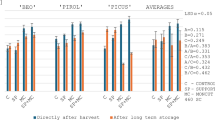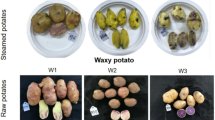Abstract
The use of unmodified starches in frozen foods is severely limited by the undesirable textural changes that occur after freezing and thawing. Retrogradation of glucan chains leads to syneresis, a separation of the starch gel and water phases. Stabilization of the starch structure is normally achieved by chemical modification to prevent these changes from occurring. We have now created a freeze–thaw-stable potato starch by alteration of starch composition and structure by genetic modification. An amylose-free starch with short-chain amylopectin was produced by simultaneous antisense downregulation of three starch synthase genes. This starch is extremely freeze–thaw stable and shows no syneresis even after five freeze–thaw cycles. The use of this starch has potential for environmental and consumer benefits because its production requires no chemical modification.
This is a preview of subscription content, access via your institution
Access options
Subscribe to this journal
Receive 12 print issues and online access
$259.00 per year
only $21.58 per issue
Buy this article
- Purchase on SpringerLink
- Instant access to full article PDF
Prices may be subject to local taxes which are calculated during checkout



Similar content being viewed by others
References
Kossmann, J. & Lloyd, J. Understanding and influencing starch biochemistry. Crit. Rev. Plant Sci. 19, 171–226 (2000).
Visser, R.G.F. et al. Inhibition of the expression of the gene for granule-bound starch synthase in potato by antisense constructs. Mol. Gen. Genet. 225, 289–296 (1991).
Jobling, S.A. et al. A minor form of starch branching enzyme in potato (Solanum tuberosum L.) tubers has a major effect on starch structure: cloning and characterisation of multiple forms of SBE A. Plant J. 18, 163–171 (1999).
Schwall, G.P. et al. Production of very-high amylose potato starch by inhibition of SBE A and B. Nat. Biotechnol. 18, 551–554 (2000).
Edwards, A. et al. Biochemical and molecular characterisation of a novel starch synthase from potato tubers. Plant J. 8, 283–294 (1995).
Abel, G.J.W., Springer, F., Willmitzer, L. & Koβmann, J. Cloning and functional analysis of a cDNA encoding a novel starch synthase from potato (Solanum tuberosum). Plant J. 10, 981–991 (1996).
Marshall, J. et al. Identification of the major starch synthase in the soluble fraction of potato tubers. Plant Cell 8, 1121–1135 (1996).
Edwards, A. et al. A combined reduction in activity of starch synthases II and III of potato has novel effects on the starch of tubers. Plant J. 17, 251–261 (1999).
Lloyd, J.R., Landschütze, V. & Kossmann, J. Simultaneous antisense inhibition of two starch synthase isoforms in potato tubers leads to accumulation of grossly modified amylopectin. Biochem. J. 338, 515–521 (1999).
Tatge, H. et al. Evidence that amylose synthesis occurs within the matrix of the starch granule in potato tubers. Plant Cell Environ. 22, 543–550 (1999).
Kuipers, A.G.J., Soppe, W.J.J., Jacobsen, E. & Visser, R.G.F. Field evaluation of transgenic potato plants expressing an antisense granule-bound starch synthase gene: increase of the antisense effect during tuber growth. Plant Mol. Biol. 26, 1759–1773 (1994).
Zheng, G.H. & Sosulski, F.W. Determination of water separation from cooked starch and flour pastes after refrigeration and freeze–thaw. J. Food Sci. 63, 134–139 (1998).
Wurzburg, O.B. & Fergason, V.L. Starch thickener characterised by improved low-temperature stability. US patent 4,428,972 (1984).
Kossman, J. et al. Cloning and functional analysis of a cDNA encoding a starch synthase isoform from potato (Solanum tuberosum L.) that is predominantly expressed in leaf tissue. Planta 208, 503–511 (1999).
Gidley, M.J. & Bulpin, P.J. Crystallisation of malto-oligosaccharides as models of the crystalline form of starch: minimum chain length required for the formation of double helices. Carbohyd. Res. 161, 291–300 (1987).
Pfannemüller, B. Influence of chain-length of short monodisperse amyloses on the formation of A-type and B-type x-ray-diffraction patterns. Int. J. Biol. Macromol. 9, 105–108 (1987).
Jobling, S.A., Schwall, G. & Westcott, R.J. Plants having reduced activity in two or more starch-modifying enzymes. WO 01/19975 patent (2001).
Safford, R. et al. Consequences of antisense RNA inhibition of starch branching enzyme activity on properties of potato starch. Carbohyd. Polym. 35, 155–168 (1998).
Acknowledgements
The authors wish to thank Anne Edwards and Alison Smith for the antisense GBSS and SSII/III potato lines; Mike Gidley and Martine Debet for useful discussions; Tina Sanders, Alice Belton, and Alison Burrows for their technical assistance; and Bob Cowper for looking after the plants.
Author information
Authors and Affiliations
Corresponding author
Rights and permissions
About this article
Cite this article
Jobling, S., Westcott, R., Tayal, A. et al. Production of a freeze–thaw-stable potato starch by antisense inhibition of three starch synthase genes. Nat Biotechnol 20, 295–299 (2002). https://doi.org/10.1038/nbt0302-295
Received:
Accepted:
Issue date:
DOI: https://doi.org/10.1038/nbt0302-295
This article is cited by
-
Physico-chemical and functional properties of starch from stored potato: effect of anti-sprouting treatments
Journal of Food Measurement and Characterization (2023)
-
Improving sulforaphane content in transgenic broccoli plants by overexpressing MAM1, FMOGS–OX2, and Myrosinase
Plant Cell, Tissue and Organ Culture (PCTOC) (2021)
-
Formation of starch in plant cells
Cellular and Molecular Life Sciences (2016)
-
Overexpression of STARCH BRANCHING ENZYME II increases short-chain branching of amylopectin and alters the physicochemical properties of starch from potato tuber
BMC Biotechnology (2015)
-
Causal Relations Among Starch Biosynthesis, Structure, and Properties
Springer Science Reviews (2014)



